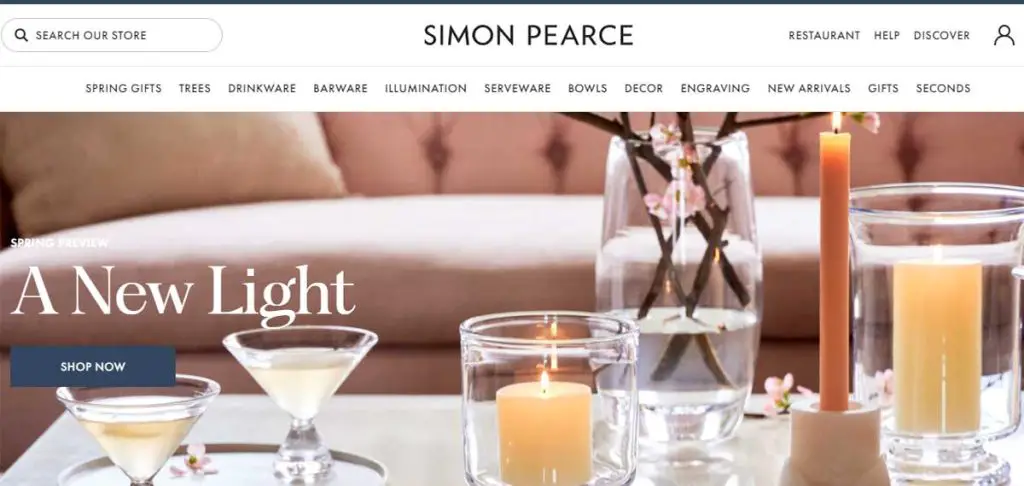Simon Pearce is renowned for its exquisite yet expensive hand-blown glass and hand-thrown pottery. With some items costing hundreds of dollars, many shoppers question what exactly warrants the lofty price tags.
Several key factors contribute to the premium pricing, including artisanal craftsmanship, high-quality American-made materials, heritage branding, and perceived value. This article will explore why Simon Pearce products come at luxury price points in line with the brand’s reputation for exceptional beauty, quality, and style.
For design aficionados seeking fine domestic craftsmanship, the nuanced elegance of Simon Pearce expresses worth equal to cost.
Reasons For Simon Pearce Being So Expensive
Here is a list of those reasons:
- Artisanal Craftsmanship
- Premium Materials
- Made in America Commitment
- Brand Value
- Perceived Value Aligns with Pricing
Let’s talk about those reasons in detail.
- Artisanal Craftsmanship

As a company founded by a glassblower and potter, Simon Pearce places great emphasis on traditional handcrafting. Every single product is shaped and decorated by master artisans, bringing a distinct human touch to each piece.
Expert glassblowers gather glowing molten glass at the end of metal blowpipes then gently blow and turn the material into delicate glasses, vases, and lamps. Skilled potters throw clay on spinning wheels then trim and finish the soft stoneware into smooth mugs, bowls, and pitchers.
This meticulous artisanal production allows for subtle variations in colors, patterns, and shapes. So even if two items are from the same product line, they will have slight differences that reflect the handmade process. Such bespoke charm comes at a cost though.
The hands-on approach severely limits the quantities that can be produced. Assembly lines of machines can mass produce container glassware and ceramics at far higher rates. But automated manufacturing lacks the nuanced artistry Simon Pearce is renowned for.
Every item also passes through multiple workshops and expert hands before completion. Master glassblowers shape the initial products then pass them on for finishing steps like attaching bases, polishing edges, and adding decorative elements.
Stoneware goes through bisque firings then multiple glazing stages before a final high temperature kiln firing. At each workshop, costs accumulate as more time, labor, energy, and care goes into a single piece.
This drawn out production process results in much higher costs compared to machine-made products. But it allows Simon Pearce to live up to its reputation for exceptional craftsmanship and attention to detail.
- Premium Materials
From the molten glass itself to the smooth glazed ceramics, Simon Pearce utilizes only the finest materials available. The lead-free glass contains premium compounds like soda-lime silica, potassium, and calcium.
These confer brilliant clarity, sonorous tone when tapped, and durability to withstand rapid temperature changes. Expert glassblowers select from a carefully curated palette of glass colors including translucent grays, greens, and blues.
More opaque options provide milky pastel hues perfect for diffusing lamp light. Elegant cuts and etchings decorate many pieces, adding to the overall material costs.
High-fire stoneware clay forms the basis for Simon Pearce’s ceramic collections. The smooth white clay fires to a non-porous, durable finish able to withstand high temperatures. Skilled artisans select from over 50 custom-developed glazes to coat the bisque pieces before firing.
The glazes contain precious metals like platinum, gold, and silver to create lustrous finishes in ivory, caramel, and stormy gray. Many glazes also have delicate crackling for Old-World charm. Such expertly formulated and applied colors elevate the ceramics far above typical earthenware pottery.
These premium materials contribute to the exceptional quality of Simon Pearce but also drive up pricing. The compounds used in the lead-free glass and artisan glazes cost more than typical formulations.
But they allow Simon Pearce to stand behind its products as chip and stain resistant for long-lasting beauty and enjoyment. For those seeking high-end tableware that will become family heirlooms, the materials are well worth the investment.
- Made in America Commitment

As both a point of company pride and cost necessity, Simon Pearce produces all its glassware and ceramics at its facilities in Vermont and New Hampshire. The brand operates a glassblowing workshop, pottery studio, on-site hydroelectric power plant, and retail stores in Quechee, Vermont.
Keeping all production in the United States rather than outsourcing to developing countries prevents Simon Pearce from taking advantage of lower labor and energy costs. But it allows for tighter quality control and the ability to closely monitor all stages of fabrication.
The made in America commitment also appeals to consumers who take pride in supporting domestic businesses. While globalized manufacturing has decreased costs across many industries, some shoppers feel special pieces like Simon Pearce glassware warrant paying more for American craftsmanship.
The same hand-blown glass or thrown pottery made overseas likely would retail for less. But Simon Pearce prioritizes its reputation as an American heritage brand, and its clients seem willing to pay the premium.
- Brand Value
Over 50 years, Simon Pearce has cultivated an upscale reputation that carries intrinsic value influencing its pricing. The backstory of Irish immigrant Simon Pearce making glass and pottery in Vermont resonates as a tale of craftsmanship and the American dream.
Today the brand evokes imagery of gracious living and timeless style. Its glassware and dinnerware grace the tables of luxury hotels, restaurants, and homes across the country. As both beautiful objects and status symbols, Simon Pearce products come with an air of aspirational lifestyle luxury.
This cultivated brand image enables Simon Pearce to command prices fit for high-end clientele. While not quite reaching the stratospheric pricing of luxury fashion, Simon Pearce items carry prestige similar to designer dresses or handbags.
Consumers drawn to brand names and reputation view the prices as matching the sophisticated appeal. Less costly options may offer similar functionality. But the Simon Pearce name holds special meaning for collectors and connoisseurs with the means to invest in pieces conveying refinement.
- Perceived Value Aligns with Pricing

For design aficionados and tableware devotees, the beauty, quality, and heritage of Simon Pearce warrant the higher costs.
The brand has won prestigious awards and placement in museum collections that testify to its enduring style. For a luxury product, real and perceived value must align.
Simon Pearce prices reflect the meticulous artisanal production, premium American-made materials, and aspirational brand image.
While not inexpensive, the pricing feels justified to loyal clients who appreciate all aspects contributing to the overall value.
Less subjective functional and decorative pieces carry more mass-market friendly pricing. But bargain hunters hoping to score a hand-blown vase or signature pottery item on clearance will find limited options. Simon Pearce maintains its reputation by keeping product costs aligned with brand positioning.
Significant discounts on this fine craftsmanship would undermine the air of exclusivity. Price-conscious shoppers can find similar items at lower price points from mass retailers.
Yet for those seeking the total package of exceptional beauty, quality, heritage, and statement luxury, Simon Pearce delivers at a commensurate price.
Also Read: This Is Why Mackenzie-Childs Is So Expensive.
Frequently Asked Questions (FAQ)
Simon Pearce is headquartered in Quechee, Vermont where the glassblowing workshop, pottery studio, hydroelectric power facilities and main retail location are located. All glassware, pottery, and other products are handcrafted on site in Quechee. The brand also operates a retail store in Windsor, Vermont and Portsmouth, New Hampshire along with other gallery locations across the United States. But everything is proudly made in Vermont.
Yes, the main Simon Pearce campus in Quechee, Vermont offers glass blowing demonstrations daily. Guests can observe the master artisans in action via an overhead viewing platform and learn about the intricate process. This allows visitors to truly appreciate the skill and care invested into every hand-blown piece.
Simon and Stephen Pearce are not related. Simon Pearce the man was an Irish immigrant glassblower and potter who founded his namesake company in 1966. Stephen Pearce is an unrelated American designer who founded his own eponymous home decor and textile brand in San Francisco in 1978. Both brands produce high-quality artisan products but do not have any family connection.
Many Simon Pearce glass and ceramic items are advertised as dishwasher safe. However, to preserve the beauty and value of handcrafted pieces, the company recommends hand washing with mild soap and a soft cloth. Avoid harsh detergents or abrasive scrubbing. Hand wash any pieces with gold or silver accents. While discontinued or specially marked dishwasher-safe lines can handle occasional machine cleaning, gentle hand washing will keep precious Simon Pearce pieces looking their best for generations. Always check care instructions for each product prior to washing.
Wrapping Up
In conclusion, Simon Pearce products warrant their premium pricing through exceptional handcraftsmanship, top-tier American materials, heritage branding, and lasting quality.
For those who appreciate fine domestic crafts and timeless style, Simon Pearce’s beauty and attention to detail justify the investment. The brand has built its reputation by delivering excellence across aesthetics, quality, and brand story to discerning clientele who value such an elevated experience.
